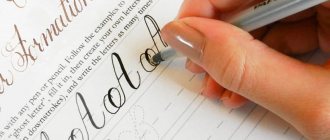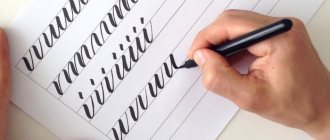January 23 is World Handwriting Day. After talking with graphologists and doing a little research of her own, m24.ru correspondent Margarita Maslova found out what can be said about a person by his handwriting, how graphology differs from handwriting studies, and why handwriting is good for emotional health.
Photo: TASS/YAY/Petro Feketa
How is handwriting formed?
According to experts, handwriting is formed from early childhood: in primary school, a child learns writing skills, by the age of 13-14, handwriting acquires individual characteristics and by the age of 18-20 it is completely formed.
Expert opinion
Primary school influences handwriting only in terms of practicing writing skills - this skill is developed and reinforced in us, but over time the child brings it to automatism and no longer pays much attention to ensuring that the letters are outlined the way they were taught in copybooks.
Usually from this moment teachers begin to say that the handwriting has “gotten bad.” In fact, it simply ceased to be stereotyped and began to reflect individual character traits. Handwriting is influenced by human nature itself. At the same time, personal characteristics are reflected in handwriting only after this skill has reached automatism.
Larisa Drygval
Head of the Center for the Study of Handwriting at the Inessa Goldberg Institute of Graph Analysis, graphologist, candidate of psychological sciences
As forensic expert and graphologist Sergei Sergeev told m24.ru, from the age of 18-20 a person develops a so-called dynamic stereotype of handwriting. If we analyze manuscripts made before this period, the data will be characterized by immaturity, since handwriting had not yet been fully formed before this time. According to the expert, it is possible to learn to write, but to unlearn it is impossible, even despite the dictatorship of the computer era.
In the 90s, scientists conducted an experiment: the experiments were associated with changes in personal characteristics and handwriting under the influence of hypnosis. Through suggestion, the subjects were returned to the age when a person was just learning to write - handwriting instantly became childish and uncertain. A similar process occurred when a person was brought into a state of more mature age - then handwriting acquired individual characteristics, became more confident and fluent.
Above is handwriting at the age of 27 in a normal state, below is handwriting of the same person under hypnosis (awareness of oneself at the age of 10).
Photo: illustration from Dmitry Zuev-Insarov’s book “Handwriting and Personality”
SHOULD YOU BE WORRIED?
The first thing to clarify is that bad handwriting is a subjective concept. If you don’t like him yourself, this does not mean that the child has problems. It’s another matter when the teacher makes a remark.
Teachers pay attention to really important points:
- the text “moves” up or down, is not on the line;
- no space between words;
- the child writes in an arbitrary part of the sheet;
- letters that are too small or large;
- different inclination and size of letters and words;
- too little or too much pressure;
- incorrect combination of letters (A and O are not different in the text);
- the same spelling of different letters (N, I, P, K and others).
What can you tell from handwriting?
Everyone writes what they breathe - this is exactly what graphologists say. Handwriting is a projection of a person’s inner world, temperament and character, his relationship to the external environment and people around him. This is a mirror of our personality, reflecting the stages of its development. As graphologist Sergei Sergeev noted, handwriting can provide a full psychological description and say a lot about intelligence, motivation, type of thinking, self-awareness and self-esteem. You can also identify the presence of fears, complexes or mental disorders.
Expert opinion: handwriting in dynamics
Handwriting is a dynamic process directly related to the nervous system and brain. The hand is an instrument with which we reflect our thoughts. Each of us consists of contradictions: our mental, nervous and creative components are constantly changing.
Here, a lot depends on the mood, age and state of health of a person, the external environment and the conditions in which this or that text was written. When performing a competent analysis, it is necessary to take into account all these factors, which is why it is advisable for a specialist to provide several handwriting samples taken at different periods of time.
Typically, people write free text and submit it for analysis along with other samples—for example, drafts written several years ago.
Sergey Sergeev
forensic expert, graphologist, handwriting expert
Larisa Drygval, head of the Center for the Study of Handwriting at the Inessa Goldberg Institute of Graph Analysis, noted that the key advantage of graphological analysis over other types of analysis is the following: graphology allows you to give a comprehensive assessment of a person in the shortest possible time. A person does not need to waste time visiting a psychoanalyst multiple times, answering questions and filling out questionnaires - it is enough to simply bring two or three A4 sheets of paper, written by hand, to the examination. This is a fairly simple method of getting to know yourself.
Crooked letters
Handwriting analysis can accurately diagnose mental disorders.
Shaky, illegible handwriting, wavy or zigzag letters are characteristic of patients suffering from alcoholism.
Trembling ornate handwriting, letters creeping on top of each other, large intervals between words, the absence of final strokes are signs of the handwriting of people with hysteria.
Lanterns (exorbitantly large letters against the background of ordinary ones) indicate partial damage (or inflammation) to a certain area of the brain.
Stretched handwriting, unnecessary curls and decorations, incompleteness, opposite inclinations are indicators of psychoasthenia (powerlessness and mental weakness).
Curved handwriting with unnecessary dots is an indicator of epilepsy. A different slant in one sentence or word suggests schizophrenia.
Narcissistic Obama and abrasive Trump. Graphologist about the handwriting of famous politicians Read more
What cannot be determined by handwriting
Photo: TASS/YAY
Handwriting can say a lot, but not everything. Three main things that handwriting is unlikely to reflect:
- Floor. It is impossible to determine whether a text was written by a man or a woman. However, in graphology there are such concepts as gendered male and female handwriting types. As graphologist Sergei Sergeev noted, the female type is characterized by roundness and archedness, while the male type is characterized by angularity and arcade (the shape of an inverted bowl). At the same time, both women and men can have handwriting that is opposite to their gender. This may indicate a predominance of the masculine principle in a woman’s character (straightforwardness, assertiveness, rationality), and in a man – a feminine one (emotionality, sociability, intuitiveness).
- Profession. It is impossible to determine by handwriting who exactly a person works, but it is possible to identify personal qualities characteristic of a particular field of activity. For example, openness and sociability are characteristic of people of humanitarian professions, restraint and an analytical mindset are characteristic of people of technical specialties. Moreover, both qualities can be successfully used in both options. As a rule, creative people are characterized by fluency in writing, while enterprising people are characterized by a predominance of sharp forms. However, it is very important to take into account other characteristics of handwriting, otherwise the analysis will be superficial.
- Actions. Graphological analysis can only determine the properties and inclinations of a person to certain actions, but not the actions themselves. Handwriting may indicate a tendency to aggression, but not the ability to kill or rob; about sensuality - but not about the ability to kiss the first person you meet.
Expert opinion: why handwriting is useful
Handwriting completely activates different parts of the brain: when writing a text by hand, there is good coordination between the left and right hemispheres. Unlike other methods of transmitting information, it is handwriting that can develop personality. Why is it so important to teach a child this skill in childhood? Because handwriting is a development that is important at the early stage of personality formation.
A person can also continue self-development through handwriting as an adult. When we write on paper, we experience what we have written not only analytically, but also emotionally. When we print, such a synergistic effect does not occur. Printed text can quickly fade from memory, but manuscripts become part of us and remain with us for a long time.
Therefore, creative individuals very often write things down by hand, so it’s easier for them to catch inspiration. Typing text on a computer coarsens our emotional state.
Larisa Drygval
Head of the Center for the Study of Handwriting at the Inessa Goldberg Institute of Graph Analysis, graphologist, candidate of psychological sciences
Diagnostics
Diagnostics involves analysis of written and oral speech. Depending on the information received, a course of treatment is drawn up. The patient is prescribed consultations with an ophthalmologist, neurologist and other specialists. The development of speech is determined by a speech therapist. The doctor examines the patient’s motor skills and determines the dominant hand. The doctor checks vocabulary, speech literacy, ability to recognize sounds, and display words on paper. To determine the cause of the syndrome, hearing and the condition of the central nervous system are checked. If necessary, computed tomography and MRI are prescribed. In the network of CMRT clinics, the examination involves the following methods:
Why is graphology needed?
Photo: TASS/YAY
Today, graphology is actively used in forensic and psychotherapeutic practices. Criminologists help to establish a person’s identity, other experts help to better understand oneself or decide on a career choice. In this context, it is important to understand the difference between graphology, aimed at analyzing personal characteristics through the prism of handwriting, and handwriting science, aimed at directly examining writing skills without any conclusions about the psychological portrait.
Expert opinion: Graphology and handwriting studies
IN FORENSICS:
In criminology, handwriting science is more involved than graphology. Handwriting science identifies handwritings: based on a comparative analysis, it helps to conclude whether what was written was written by the same person or not.
Handwriting is used to establish identity. Graphology, on the other hand, makes it possible to determine a psychological portrait - in forensic science, it can provide secondary values for detecting a person who is wanted.
HANDWRITING AND SIGNATURE:
In handwriting studies, handwriting and signature are considered two independent objects, equally informative. In graphology they are informative only if they are considered together. A signature is a business card that speaks about how a person wants to appear.
A signature is an image that may not correspond to real mental content. Moreover, a person can have several signatures. From a graphological point of view, handwriting provides more detailed information than a signature.
Sergey Sergeev
forensic expert, graphologist, handwriting expert
As noted by candidate of psychological sciences, graphologist Larisa Drygval, graphology is only a method of psychodiagnostics through handwriting, therefore, ideally, a good graphologist should be a professional psychologist who has completed professional retraining courses at specialized institutes, which should take at least a year and a half.
According to her, the main feature of a graphologist is the desire for knowledge. The specialist must be as impartial as possible. He should not have any sympathy or affection for the client. Each person has his own pros and cons, and the task of a graphologist is to understand the balance of these characteristics, so as not to exaggerate some and not level out others.
Expert opinion: who comes to a graphologist and why
Most often, people come to a graphologist to understand themselves - their inner world, their states. People are trying to know themselves and improve their lives in a qualitative way. Graphological analysis can help understand the causes of problems with work or personal relationships.
People also often turn to a graphologist for help with career guidance. Parents of children entering universities often come for this reason, so that the choice of institute is related to the child’s inclinations and is not forced.
A similar request comes to graphology centers from clients over 30 years of age who have already graduated, worked in their specialty and realized that this is not their profession - consultations with a graphologist help them better understand themselves and find something that would truly meet their abilities and desires.
Larisa Drygval
Head of the Center for the Study of Handwriting at the Inessa Goldberg Institute of Graph Analysis, graphologist, candidate of psychological sciences
Interpreting handwriting correctly: life hacks from graphologists
Photo: TASS/YAY
In order for the graphological analysis to be complete, experts recommend adhering to the following conditions when writing text:
- The manuscript must be written on a blank, unlined sheet of A4 format;
- Be sure to write with a blue ballpoint pen on a flat surface; you need to place at least three more sheets of paper under the paper - this will make it possible to take into account such a characteristic as pressure;
- The text should be free: when rewriting ready-made phrases or quoting, a person will have more control over himself. For graphological analysis, freedom of writing is important, more clearly reflecting internal and unconscious processes;
- A couple of phrases are not enough for a full analysis. Ideally, at least two or three A4 sheets should be written on;
- It is advisable for the specialist to have handwriting samples from different periods of time. This will allow us to take into account the dynamics of personality development and separate permanent factors (mood, poor health) from unchanged personal characteristics.
Autograph of a person with a mental disorder.
Photo: illustration from Dmitry Zuev-Insarov’s book “Handwriting and Personality”
After a correctly completed sample has been received, you can proceed directly to interpreting what was written. Conventionally, we can identify several basic characteristics of handwriting that need to be taken into account when analyzing it:
- Shape/height/width: can tell about a person’s relationship with the internal and external worlds;
- Pressure: shows the degree of energy of a person;
- Movement, writing fluency: speaks about the speed of mental processes;
- Continuity: indicates a sequence of actions;
- Slope: speaks of the movement of emotions;
- Homogeneity: constancy/inconsistency of personal qualities;
- Line formations: will help in drawing up a psychological portrait;
- Use of space on paper: gravitation towards the past/future, conscious/unconscious;
- Line shapes: can say a lot about a person's temperament.
As examples, graphologist Sergei Sergeev cited rounded handwriting (arc elements of forms - openness, cheerfulness, emotions, feelings), large handwriting (extroversion, thoroughness, self-confidence), small handwriting (introversion, fatigue), fast writing speed, which speaks of a person’s flexibility, and slow speed, which may indicate a stubborn nature.
Handwriting of Alexander Pushkin.
Photo: illustration from Dmitry Zuev-Insarov’s book “Handwriting and Personality”
An interesting example would be the natural calligraphic handwriting of an adult who writes this way all the time (important: moments when people deliberately try to write beautifully, for example, when making cards or filling out documents, do not count). According to graphologists, a regular desire for stylization may indicate excessive concentration on form rather than content. As Sergeev noted, if a person writes in a stylized manner all the time, he can be secretive and constantly keep himself within limits, trying to demonstrate to those around him that everything in his life is perfect.
Form
The shape of the handwriting can be round, angular, or printed. Beautiful rounded letters indicate that the person who wrote them has a cheerful and kind character. This is probably a harmonious, calm personality. She treats other people with patience and understanding.
Angular letters are evidence of independence, leadership, the desire to be critical of everything, and not to succumb to the thoughtless persuasion of others. A tendency to compete is often found.
What does our handwriting say about us?
Angular handwriting can be confused with sharp handwriting. In relation to the owners of the latter, they say that they can be aggressive, at the same time insightful and intelligent. They are accused of selfishness and ignoring the interests of other people.
Hidden behind the hand-written block letters is a person with developed self-control. He constantly monitors his own and others’ behavior and emotions. Tends to wear a mask that well hides his true self. From here we can talk about a lack of trust, perhaps attempts to protect oneself from the assessments and criticism of others.











